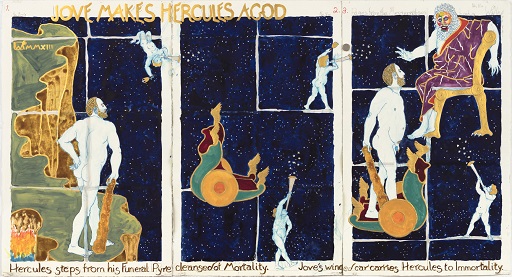4.1 The shapes humans can take
Many of Ovid’s stories of metamorphosis involve a human becoming a plant, animal or god/goddess.
In the next activity, you will encounter some of these stories of transformation from Ovid’s Metamorphoses, through some of the art works that they have inspired.
Activity 7 The art of transformation
Below are two modern art works that take their inspiration from the stories of transformation that Ovid tells in his Metamorphoses. Study each image for about five minutes, and write down which figures are changing and how. What kind of transformation do you think is taking place in each story (e.g. from human to animal, from human to god etc)?

Note: ‘Jove’ is another name for the god Jupiter.
Discussion
In the first image by Wally Reinhardt, the painter gives us quite a lot of information about the transformation that is taking place. The text at the top of the painting reads ‘Jove makes Hercules a god’, and we can tell from the comic strip style panels that Hercules is being transformed from a hero into an immortal god.
In the second image by Ana Maria Pacheco, we have to do a bit more detective work because the artist does not tell us exactly what is happening. The pig-like creatures on the right-hand side of the image are standing on their hind legs and raising their heads to look at each other. We might hypothesise that they are humans who have recently been transformed into pigs.
If you would like to know more about these stories, you could read the story that inspired each of these paintings in Stephanie McCarter’s translation in the ‘Taking it further’ section of this course. Rather than delve into the story of Hercules transformed into a god (Metamorphoses Book 9) or of Circe who transforms Odysseus’ shipmates into pigs (Metamorphoses Book 14) further here, you are going to think about the big question that is common to these kinds of stories about transformation: when does a human stop being human?

